|
 LAKE BAIKAL
LAKE BAIKAL
|
|
There
is probably no more beautiful place in all Russia than Lake Baikal, the 'Pearl
of Siberia' - crystal clear (and, for the most part, drinkably pure), set round
with mountains and lined with little settlements of wood cabins.
"Russia, Ukraine, Belarus", Lonely Planet, 2000, page 642
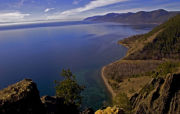 Creating
her favorites, Mother Nature touches them up with particular thorough and vests
absolute power in them. Lake Baikal is undoubtedly this kind of an object. Baikal
is a whole universe, for more than 30 million years developing its own way,
keeping many secrets deep in the dark waters and leaving unforgettable impressions
in every heart of the human, ever visited its shores. Creating
her favorites, Mother Nature touches them up with particular thorough and vests
absolute power in them. Lake Baikal is undoubtedly this kind of an object. Baikal
is a whole universe, for more than 30 million years developing its own way,
keeping many secrets deep in the dark waters and leaving unforgettable impressions
in every heart of the human, ever visited its shores.
Baikal's coastline stretches for over 1300 miles. Surprisingly,
wouldn't it be easier for us to imagine hundreds of thousands miles in the spatial
emptiness on the way to the moon than these thirteen hundred miles in majestic
and live beauty open for hiking and unhurried views. Nonetheless, one is unable
to contain all these pictures within oneself. They are greater more beautiful,
more varied and amazing than we are capable of comprehending with our understandings
and senses. That can only be believed, unlike the astronomic distances to heavenly
bodies.
 This
has to be believed as well as Baikal basin's volume does ( 5520 cubic miles,
20 percent of all freshwater on the earth surface); the depth of its bed-load
deposits do ( up to 4-5 miles); the number of its water and coastline dwellers
do ( hundreds and hundreds of endemic animals and plants absent anywhere else
in the world); and a lot more of other things which are hard to believe. This
has to be believed as well as Baikal basin's volume does ( 5520 cubic miles,
20 percent of all freshwater on the earth surface); the depth of its bed-load
deposits do ( up to 4-5 miles); the number of its water and coastline dwellers
do ( hundreds and hundreds of endemic animals and plants absent anywhere else
in the world); and a lot more of other things which are hard to believe.
We organize accommodation in hotels and homestays in different
settlements at lake Baikal's coast: Listvyanka, Bolshie Koty, Bolshoe Goloustnoe,
Khuzir (the Olkhon island), Severobaikalsk. We offer a number of tours to Lake
Baikal ( from a day excursion to Listvyanka , visits to Museum of Wooden Architecture
and Limnological Museum, up to a week trekking along the shore). Boat trips
from 1 hour to 8 days to the north part of the lake. You can also choose one
of our jeep, sea-kayaking, bicycling, scuba diving or white water programs.
 IRKUTSK
IRKUTSK
|
|
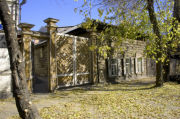 Irkutsk is the most popular stop for the Trans - Siberian travelers. In this
city, which was once known as the "Paris of Siberia", you will find people rather
more friendly and relaxed than those in Moscow and other Russian major cities
on the west. Along many of the streets you can still see the cozy - looking
log cabins (eaves and windows decorated with intricate fretwork) which are typical
for the Siberian style of domestic architecture. Irkutsk was founded as a military
outpost in 1661 by Ivan Pakhabov, Cossack and tax collector who had come to
encourage the local Buryat tribesmen to pay their fur tribute. By 1686 a church
had been built and a small town established on the bank of Angara. Tea caravans
from China passed though Irkutsk, fur traders sold their pelts here, gold was
found around and the town quickly developed into a center for trade in Siberia.
Irkutsk is the most popular stop for the Trans - Siberian travelers. In this
city, which was once known as the "Paris of Siberia", you will find people rather
more friendly and relaxed than those in Moscow and other Russian major cities
on the west. Along many of the streets you can still see the cozy - looking
log cabins (eaves and windows decorated with intricate fretwork) which are typical
for the Siberian style of domestic architecture. Irkutsk was founded as a military
outpost in 1661 by Ivan Pakhabov, Cossack and tax collector who had come to
encourage the local Buryat tribesmen to pay their fur tribute. By 1686 a church
had been built and a small town established on the bank of Angara. Tea caravans
from China passed though Irkutsk, fur traders sold their pelts here, gold was
found around and the town quickly developed into a center for trade in Siberia.
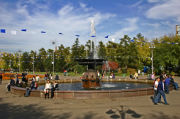 By
the middle of the 19-th century Irkutsk was recognized as Siberia's administrative,
financial and cultural capital. Its cosmopolitan population included fur traders,
tea merchants, gold prospectors, officials, craftsmen and ex- convicts. Being
the capital Irkutsk was the destination of many exiled nobles from West Russia.
The most celebrated exiles were the Decembrists, who had attempted a coup in
St Peterburg in 1825. Now a days, with the population about 600 000 people,
Irkutsk is one of the largest Siberian cities, with more than 10 state universities,
scientific town and service & engineering as the main activity. Most of
the brick mansions and grand public buildings varying in architectural styles
were constructed in the late 19th - early 20th century. Several beautiful Russian
Orthodox churches and a Polish Cathedral are located in downtown, near the central
square. By
the middle of the 19-th century Irkutsk was recognized as Siberia's administrative,
financial and cultural capital. Its cosmopolitan population included fur traders,
tea merchants, gold prospectors, officials, craftsmen and ex- convicts. Being
the capital Irkutsk was the destination of many exiled nobles from West Russia.
The most celebrated exiles were the Decembrists, who had attempted a coup in
St Peterburg in 1825. Now a days, with the population about 600 000 people,
Irkutsk is one of the largest Siberian cities, with more than 10 state universities,
scientific town and service & engineering as the main activity. Most of
the brick mansions and grand public buildings varying in architectural styles
were constructed in the late 19th - early 20th century. Several beautiful Russian
Orthodox churches and a Polish Cathedral are located in downtown, near the central
square.
We offer a variety of accommodations from Deluxe apartments
to inexpensive hostels and homestays Russian hospitality. Walking city tour or tour by car,
museums and churches of Irkurtsk, cultural and folk programs are to your pleasure.
 OLKHON ISLAND
OLKHON ISLAND
|
|
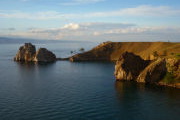 Olkhon is the largest island at Lake Baikal. It is 71 km long and 15-25 km wide.
Olkhon is the most beautiful and mysterious place at the lake. The climate and
landscape here are different from the rest of the lake. Average temperature
in Summer is 20 - 23°C above zero, many sunny days, rains are seldom. In winter
there is not much snow, windy, temperature is about -20°C. Nature of Olkhon is
outstandingly various: there are gorgeous sandy beaches, spacious steppe hills,
dramatic capes, pine-tree forests and picturesque rocks, beautifully coloured
with yellow, red, orange lichens. The island's dry southern end is rolling grassland
- great for off-road mountain bike. This transform in the mid part into thick
woodland and at the northern tip there's a fair chance of spotting freshwater
seals. The channel between the island and the mainland is called Maloe More,
it is one of the few places at Baikal where water in summer is warm enough for
swimming. The island had been formed during millions of years of tectonic development.
Lake Baikal's deepest point (1637m) is near the Eastern Shore of the Island.
Olkhon is the largest island at Lake Baikal. It is 71 km long and 15-25 km wide.
Olkhon is the most beautiful and mysterious place at the lake. The climate and
landscape here are different from the rest of the lake. Average temperature
in Summer is 20 - 23°C above zero, many sunny days, rains are seldom. In winter
there is not much snow, windy, temperature is about -20°C. Nature of Olkhon is
outstandingly various: there are gorgeous sandy beaches, spacious steppe hills,
dramatic capes, pine-tree forests and picturesque rocks, beautifully coloured
with yellow, red, orange lichens. The island's dry southern end is rolling grassland
- great for off-road mountain bike. This transform in the mid part into thick
woodland and at the northern tip there's a fair chance of spotting freshwater
seals. The channel between the island and the mainland is called Maloe More,
it is one of the few places at Baikal where water in summer is warm enough for
swimming. The island had been formed during millions of years of tectonic development.
Lake Baikal's deepest point (1637m) is near the Eastern Shore of the Island.
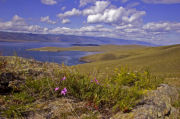 On
the island there are several small lakes, the highest mountain is the forbidden
Zhima Peak, 1300m-high, long time a place for shaman's ceremonies and funerals.
Olkhon Island has several archaeological sites, beginning with the remains of
an Iron Age fortress built by mysterious Kurykans, the ancient Chinese people
who lived here between 500 and 1000 AD. The Island is famous as the centre of
Shamanism, the common religion of the indigenous peoples of Siberia - Buryats.
Many of the shamans sacred places and rock paintings are still found here. The
biggest settlement of Olkhon is the fishing village of Khuzhir with population
of about 2.000 people . On
the island there are several small lakes, the highest mountain is the forbidden
Zhima Peak, 1300m-high, long time a place for shaman's ceremonies and funerals.
Olkhon Island has several archaeological sites, beginning with the remains of
an Iron Age fortress built by mysterious Kurykans, the ancient Chinese people
who lived here between 500 and 1000 AD. The Island is famous as the centre of
Shamanism, the common religion of the indigenous peoples of Siberia - Buryats.
Many of the shamans sacred places and rock paintings are still found here. The
biggest settlement of Olkhon is the fishing village of Khuzhir with population
of about 2.000 people .
Ferry operates from mid-May till mid-November from 09:00 am
till 8:00 pm. In wintertime (from the end of January till the beginning of April)
it is possible to go to the island on the ice from mainland.
"BAIKALCOMPLEX" arranges variety of cultural and JEEP
TOURS to Olkhon with overnight in family pension in Khuzhir or camping in
tents at lake's shore.
 LISTVYANKA
LISTVYANKA
|
|
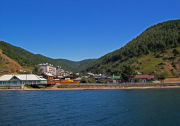 The small but tourist-wise village of Listvyanka is located on the shore of
Lake Baikal, 70 km from Irkutsk. Russian pioneers came to this spot in the middle
of the 17th century, and a hundred years later there was a outpost here. The
settlement grew along with the development of navigation on Lake Baikal. This
old-style Siberian village, situated at the source of the Angara River, is famous
for its trade history. From the 18th century a ferry took merchants across the
lake on their way to Mongolia, China and the Far East.
The small but tourist-wise village of Listvyanka is located on the shore of
Lake Baikal, 70 km from Irkutsk. Russian pioneers came to this spot in the middle
of the 17th century, and a hundred years later there was a outpost here. The
settlement grew along with the development of navigation on Lake Baikal. This
old-style Siberian village, situated at the source of the Angara River, is famous
for its trade history. From the 18th century a ferry took merchants across the
lake on their way to Mongolia, China and the Far East.
Despite its modest size Listvyanka is one of the busiest tourist
centers in the whole of Siberia. Due to its proximity to Irkutsk, it sees probably
more visitors than all other towns and villages on Lake Baikal combined - particularly
weekending locals and foreign tourists. Village is relatively overdeveloped,
with a tourist-oriented market, picnic areas and a plethora of hotels and cafes.
Listvyanka is the site of the Limnological Institute of the
Russian Academy of Sciences. It studies the lakes and man-made reservoirs of
Siberia and the Russian Far East, with particular focus on Lake Baikal. The
institute has a small but very interesting museum of the flora and fauna of
Baikal and its region. Population of Listvyanka is about 2,300
We offer a range of accommodation in Listvyanka, from 3-4* hotels
to homestay and hostel. Our travel company owns"LISTVYANKA
CHALET", budget friendly comfortable lodge. Build in 2005 out of Siberian pinetree
logs, chalet has 13 suit-in rooms.The friendly staff will support you with tourist information and
help to organize your activity around Listvyanka. We arrange excursions, hikings,
circumbaikal raiway tours, dog sledding, diving in Listvyanka etc. Enjoy our hospitality and you always welcomed !
 BOLSHIE KOTY
BOLSHIE KOTY
|
|
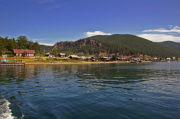 Bolshie Koty is a small village, located on the lakeside 20 km northeast from
a popular tourist destination - Listvyanka. There is no automobile road to this
small place, and one can get there only by feet or by boat. The trail is a beautiful
20 km hike along the shore, slightly going up and down. In summer there are
regular public boat connection with Irkutsk and Listvyanka, hydrofoils depart
daily.
Bolshie Koty is a small village, located on the lakeside 20 km northeast from
a popular tourist destination - Listvyanka. There is no automobile road to this
small place, and one can get there only by feet or by boat. The trail is a beautiful
20 km hike along the shore, slightly going up and down. In summer there are
regular public boat connection with Irkutsk and Listvyanka, hydrofoils depart
daily.
Surrounded by woody hills and picturesque cliffs this solitude
place has its own life rhythm measured not by hours and days but with the sunshine
and seasons. Gold used to be extracted from the Bolshie Koty River and the rusting
dredge can still be seen 1 km beyond the village. In the times of the gold rush
the village used to have own bakery, power-saw bench, small glass factory etc.
Nowadays the main activities for 60 inhabitants of Koty settlement are fishing,
work at the Irkutsk University Research Station and growing tourism. In summer
the place gets busier with students doing their practical work, locals camping
in the nearby valleys and western tourist, came to see the true Baikal background.
Easy walks, bright colors, forests full of mushrooms and wild berries together
with outstanding lake's beauty will take your heart forever.
Crime free and with health microclimate, it is ideal against
stress, for getting in shape and rest from the city noise and traffic. The area
is rich in natural beauty and history, making it a superb base culture holidays and for action adventures.
Poor tourist infrastructure gives you limited possibilites
to dine and stay overnight in the village.
 CIRCUMBAIKAL RAILWAY
CIRCUMBAIKAL RAILWAY
|
|
 The section of the Trans - Siberian Railroad on the southern
shore of Baikal from Port Baikal to Kultuk is called the Circumbaikal Railway.
From 1900 to 1904 the raiway tracks from Irkutsk stopped at Port Baikal, across
the mouth of the Angara from Listvyanka. From here ice-breaking steam ships
carried passengers and trains across the lake, where rails continued. It took
4 years to put the first line around southwestern shore of Baikal and completed
the Trans-Siberian. Extension of this line is 84 km, it is the shortest but
most difficult section of the whole railroad, it required a tunnel or bridge
almost every kilometer. Circumbaikal Railway is a kind of museum of engineering
constructions and building art. It is the place where the stonework of tunnels'
portals, bearing walls, arches and different picturesque rocks have run into
one in a remarkable manner. Railroad includes monuments of architecture, engineering
and technical art (tunnels, galleries, bridges, viaducts and bearing walls).
56 tunnels, galleries and other detached buildings, 248 bridges and viaducts,
268 bearing walls, 172 monuments of architecture survive to this day. Together
with Russian employees, skilled Italian, Turkish and Chinese contract mason
took part in building of bridges and tunnels.
The section of the Trans - Siberian Railroad on the southern
shore of Baikal from Port Baikal to Kultuk is called the Circumbaikal Railway.
From 1900 to 1904 the raiway tracks from Irkutsk stopped at Port Baikal, across
the mouth of the Angara from Listvyanka. From here ice-breaking steam ships
carried passengers and trains across the lake, where rails continued. It took
4 years to put the first line around southwestern shore of Baikal and completed
the Trans-Siberian. Extension of this line is 84 km, it is the shortest but
most difficult section of the whole railroad, it required a tunnel or bridge
almost every kilometer. Circumbaikal Railway is a kind of museum of engineering
constructions and building art. It is the place where the stonework of tunnels'
portals, bearing walls, arches and different picturesque rocks have run into
one in a remarkable manner. Railroad includes monuments of architecture, engineering
and technical art (tunnels, galleries, bridges, viaducts and bearing walls).
56 tunnels, galleries and other detached buildings, 248 bridges and viaducts,
268 bearing walls, 172 monuments of architecture survive to this day. Together
with Russian employees, skilled Italian, Turkish and Chinese contract mason
took part in building of bridges and tunnels.
 In 1957 the Irkutsk dam was erected and the part of the original railroad from
Irkutsk to Port Baikal was flooded. This section was replaced with the shortcut,
going strait from the city to south extremity of Baikal. It turned Circumbaikal
to a rarely used branch line. Nowadays the railroad is mostly used as a tourist
destination for the local people to camp on weekends, as well as for famous
tourist trains, such as "Tsaren Gold", "Orient Express" and others.
In 1957 the Irkutsk dam was erected and the part of the original railroad from
Irkutsk to Port Baikal was flooded. This section was replaced with the shortcut,
going strait from the city to south extremity of Baikal. It turned Circumbaikal
to a rarely used branch line. Nowadays the railroad is mostly used as a tourist
destination for the local people to camp on weekends, as well as for famous
tourist trains, such as "Tsaren Gold", "Orient Express" and others.
 The
Circum-Baikal Railroad 100 years' anniversary The
Circum-Baikal Railroad 100 years' anniversary
ONE DAY CIRCUMBAIKAL RAIWAY TOUR - the culture explorations
for inquisitive, active travelers who appreciate train journeys, historical
sites and beautiful nature.
 TUNKA VALLEY
TUNKA VALLEY
|
|
 One of the most attractive wild areas for all kinds of travelers and adventurers,
photographers as well, it was named after a small river that leaves deep and
narrow canyon in the ridges for flat plains of the valley. Connected with a
good paved way with Sludyanka Trans-Siberian railway station and Federal Highway
M55, Tunka is a lot more populated than Oka region. The valley of Tunka is sprinkled
with settlements as it is good for agriculture and herding, with rich soils
and good pastures. Area is populated with Siberia indigenous Buryat people,
the descendants of Mongols, mainly busy in cattle breading and agriculture.
The region is well-known among adventurers first of all because of Tunkinsky
Range of Eastern Sayan mountain country. Perfect for backpacking tours, it's
also excellent for rafters, kayakers, and particularly for mountaineers and
rock climbers. The climate in whole is continental, summers are long and mild,
wintertime is characterized by strong frosts starting from November and fading
out in February. The whole area bears traces of ancient glaciering, with sharp
pyramid summits and deepened cirques, hemmed around with old moraines, the ridges
of a sierra type with vertical rock faces and steep cliffs. Glaciers are now
replaced by deep and clear lakes with ice cold water. Mountain passes mostly
are rocky saddles, with steep slopes lined by long screes with patches of green
grass. The absolute altitude of the range is around 3000 m over ocean level.
One of the most attractive wild areas for all kinds of travelers and adventurers,
photographers as well, it was named after a small river that leaves deep and
narrow canyon in the ridges for flat plains of the valley. Connected with a
good paved way with Sludyanka Trans-Siberian railway station and Federal Highway
M55, Tunka is a lot more populated than Oka region. The valley of Tunka is sprinkled
with settlements as it is good for agriculture and herding, with rich soils
and good pastures. Area is populated with Siberia indigenous Buryat people,
the descendants of Mongols, mainly busy in cattle breading and agriculture.
The region is well-known among adventurers first of all because of Tunkinsky
Range of Eastern Sayan mountain country. Perfect for backpacking tours, it's
also excellent for rafters, kayakers, and particularly for mountaineers and
rock climbers. The climate in whole is continental, summers are long and mild,
wintertime is characterized by strong frosts starting from November and fading
out in February. The whole area bears traces of ancient glaciering, with sharp
pyramid summits and deepened cirques, hemmed around with old moraines, the ridges
of a sierra type with vertical rock faces and steep cliffs. Glaciers are now
replaced by deep and clear lakes with ice cold water. Mountain passes mostly
are rocky saddles, with steep slopes lined by long screes with patches of green
grass. The absolute altitude of the range is around 3000 m over ocean level.
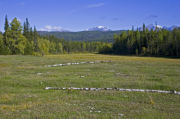 Surrounding
taiga (Boreal forest)is abundant with wildlife and different kinds of wild berries,
such as raspberry, redberry ( Russian "brusnika", also called as billberry,
mountain cranberry), blueberry (Russian "golubika"), huckleberry (Russian
"chernika"), bittersweet (honeysuckle) and others. Partly taiga consists
of Siberian stone pine which is called "cedar" by locals. The nuts
of this tree previously served a perfect raw material for cedar oil, that was
replaced by sunflower oil later. The snow melts by June, though in cirques and
canyons it can lie all summer through. Northern sides of peaks and passes are
covered with deep snow till mid June. Local population uses horses to ride over
the ridges through flattened low passes with good horse trails. It is also possible
to arrange horsebacking trips to the main highlight of the Range Shumak Spring
Valley. Along the southern foot of the Range there are a lot of spots with mineral
water springs which are utilized by people as a medicine for a number of diseases.
The most popular and wellknown are two of them - Arshan and Nilova Pustyn resorts,
spa villages with developed infrastructure, good warm curative baths, drinking
water springs, hotels and hostels and small cafes along the streets. Since 80-s
the whole territory of Tunka region announced a National park. Surrounding
taiga (Boreal forest)is abundant with wildlife and different kinds of wild berries,
such as raspberry, redberry ( Russian "brusnika", also called as billberry,
mountain cranberry), blueberry (Russian "golubika"), huckleberry (Russian
"chernika"), bittersweet (honeysuckle) and others. Partly taiga consists
of Siberian stone pine which is called "cedar" by locals. The nuts
of this tree previously served a perfect raw material for cedar oil, that was
replaced by sunflower oil later. The snow melts by June, though in cirques and
canyons it can lie all summer through. Northern sides of peaks and passes are
covered with deep snow till mid June. Local population uses horses to ride over
the ridges through flattened low passes with good horse trails. It is also possible
to arrange horsebacking trips to the main highlight of the Range Shumak Spring
Valley. Along the southern foot of the Range there are a lot of spots with mineral
water springs which are utilized by people as a medicine for a number of diseases.
The most popular and wellknown are two of them - Arshan and Nilova Pustyn resorts,
spa villages with developed infrastructure, good warm curative baths, drinking
water springs, hotels and hostels and small cafes along the streets. Since 80-s
the whole territory of Tunka region announced a National park.
"BAIKALCOMPLEX" offers JEEP TOUR TO TUNKA
VALLEY - with visiting Arshan spa, Buddhist temple, a day soft walk up the
gorge of Kyngarga river. Overnight in family pension or hotel.
 SHAMANISM
SHAMANISM
|
|
 Since long before coming the Christianity, the common religion of the indigenous
peoples of Siberia has been shamanism, a form of pagan earth-reverence that
dates back to the Stone Age. Shamanism take many forms with each tribe and clan
having different traditions and practices. However all forms are based on the
belief in a universe consisting of the three worlds, connected together. The
upper world is inhabited by gods, the middle with the people and animals, and
the lower by the spirits of the dead. In the human world, nature is dominated
by occult forces from the other two worlds. Man is considered to be an inevitable
part of the Nature, but not its "King", respecting, sometimes worshiping other
creatures and never wasting nature's gifts. Shamanism, as well as animism, assume
the presence of spirits or spiritual qualities in objects of the natural world.
Essential is the idea that animals and birds, equally to humans, possess identities
and after death their soles travel to the lower world. Philosophically the core
of belief is a need of ecological balance. Every natural object, particularly
mountains and springs, are believed to have a sole which should be consciously
thanked with small offerings. This practice remains most visibly apparent in
Tuva, Khakassia, Burytia and Altay with prayer ribbons tied to holy trees and
stone cairns beside mountain passes.
Since long before coming the Christianity, the common religion of the indigenous
peoples of Siberia has been shamanism, a form of pagan earth-reverence that
dates back to the Stone Age. Shamanism take many forms with each tribe and clan
having different traditions and practices. However all forms are based on the
belief in a universe consisting of the three worlds, connected together. The
upper world is inhabited by gods, the middle with the people and animals, and
the lower by the spirits of the dead. In the human world, nature is dominated
by occult forces from the other two worlds. Man is considered to be an inevitable
part of the Nature, but not its "King", respecting, sometimes worshiping other
creatures and never wasting nature's gifts. Shamanism, as well as animism, assume
the presence of spirits or spiritual qualities in objects of the natural world.
Essential is the idea that animals and birds, equally to humans, possess identities
and after death their soles travel to the lower world. Philosophically the core
of belief is a need of ecological balance. Every natural object, particularly
mountains and springs, are believed to have a sole which should be consciously
thanked with small offerings. This practice remains most visibly apparent in
Tuva, Khakassia, Burytia and Altay with prayer ribbons tied to holy trees and
stone cairns beside mountain passes.
Spiritual guidance was traditionally offered by shaman: a high
priest, prophet and doctor rolled into one. Shamanism is an aggressive discipline
involving constant combat with occult forces, demons and evil spirits. The contacts
and battles are archived during an ecstatic state induced by dancing, drum beating
and occasionally by eating hallucinogenic mushrooms and plants. Although Buddhism
and Christianity are now mainly confessed in Burytia, however, there are still
many practicing shamans, especially in the western part.
"BAIKALCOMPLEX" offers ONE DAY TOUR TO SHAMANS
- the comprehensive trip to Buryat village Ust-Orda, with the folk show, visiting
the local lore museum and meeting shaman and taking part in shaman ceremony.
|
 |
|
 |



